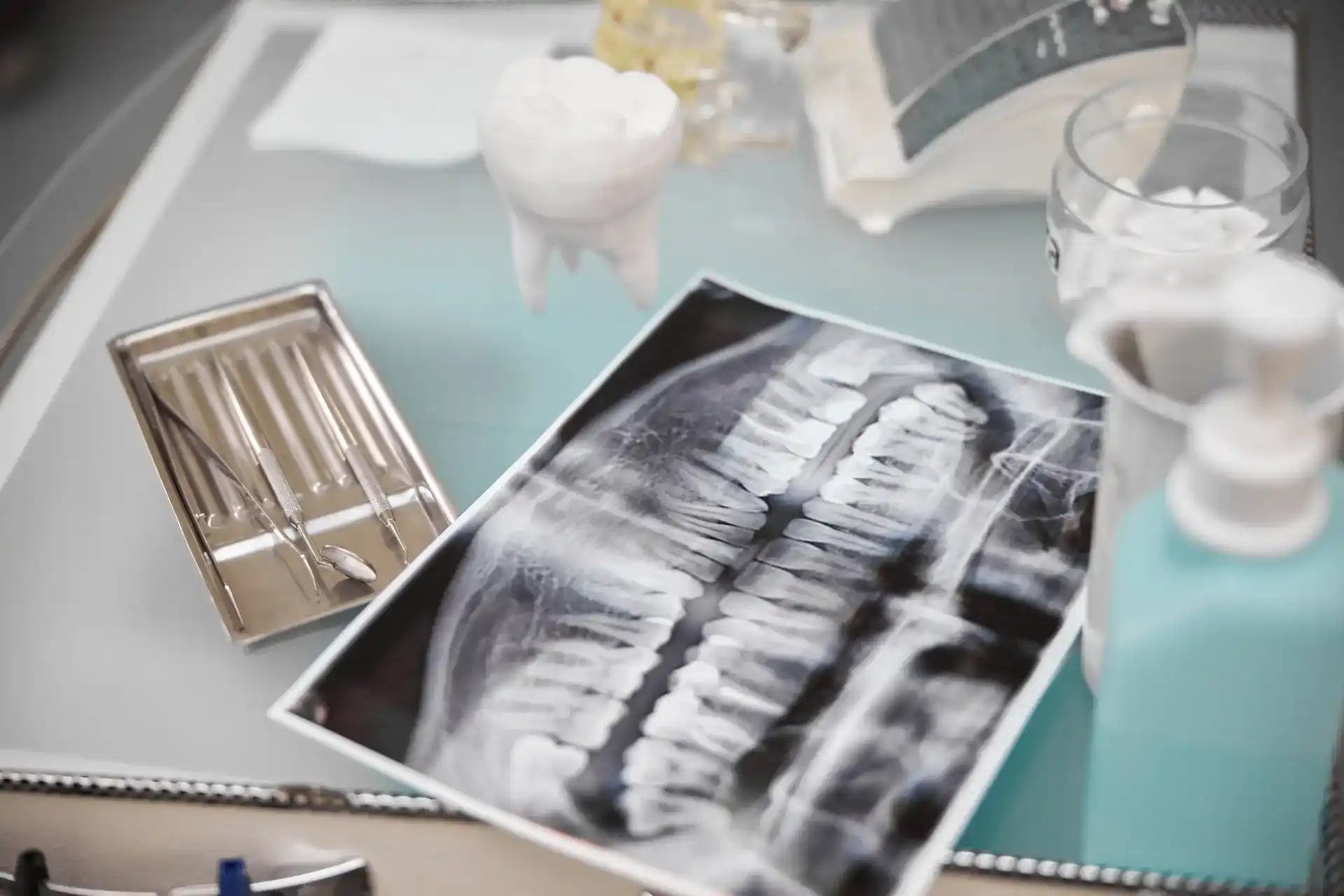Many dental teams run into questions when it comes to using the FMX dental code (D0210) correctly.
Billing for full mouth X-rays should be simple, but vague ADA guidelines, shifting insurance rules, and outdated CDT codes often make it more complicated than it needs to be.
Even a small mistake can lead to claim delays or denials.
The FMX dental code can be tricky, especially when you're dealing with insurance requirements, overlapping codes, and documentation rules.
Whether it's referred to as the ADA code for FMX, FMX CDT code, or simply dental code D0210, understanding when and how to use it correctly is key to avoiding billing issues.
Let’s make full mouth X-ray billing a little less complicated.
What is the FMX Dental Code (D0210)?
The FMX dental code D0210 is used when a dentist takes a complete set of X-rays, known as a Full Mouth Series (FMX).
This includes multiple images that show all the teeth, including the roots and the bone around them.
These X-rays help the dentist get a full picture of the patient’s oral health, beyond what can be seen during a regular visual exam.
D0210 is the official CDT code used to bill insurance for this procedure.
If only a few X-rays are taken, like just bitewings or a single periapical image, different codes should be used instead.
What’s Included in an FMX?
An FMX typically includes:
- Periapical X-rays (which show the whole tooth, from crown to root)
- Bitewing X-rays (which show the upper and lower teeth in one area)
Together, these images give a detailed view of the whole mouth. An FMX usually includes 14 to 22 individual images, depending on the patient.
These images are usually taken during a new patient exam or every 3-5 years to check for decay, bone loss, infection, and other dental issues that aren’t visible to the eye.
What are the Benefits of Using the Dental FMX Code (D0210)?
Here are some important benefits of using the Dental FMX code (D0210) for full mouth X-rays:
Finding Hidden Dental Problems
Full mouth X-rays, billed with the D0210 code, help dentists spot issues that you can’t see just by looking.
These can include cavities, impacted wisdom teeth, cysts, tumors, or problems with how your teeth and jaw are developing. Catching these early can lead to better treatment and faster care.
Tracking Treatment Progress
Regular full mouth X-rays allow dentists to see how well your treatment is working.
By comparing current images with past ones, they can make sure everything is on track or make changes if needed to keep your oral health in the best shape.
Helping with Orthodontic Care
In orthodontics, full mouth X-rays with the D0210 code give important information.
They help check how permanent teeth are coming in and whether the jaws are properly aligned.
This helps orthodontists plan and guide your treatment accurately.
When Should You Use the FMX Code (D0210)?
Use D0210 when you’re billing for a complete set of intraoral X-rays that were taken for a diagnostic reason, not just routine imaging or a few isolated views.
Bill D0210 when:
- The dentist needs a full-mouth evaluation due to symptoms, history of disease, or treatment planning
- The X-rays are medically necessary, not just routine
- It meets the patient’s insurance frequency limits (usually every 3–5 years)
- You’ve documented the reason clearly in the patient’s chart
What Insurance Carriers Look For:
- Medical necessity - not just a “new patient”
- Clinical notes that support why the FMX was needed
- No unbundling (don’t bill individual X-rays separately when a full set was taken)
Keep it simple:
Only use D0210 when the full series is taken for a specific diagnostic purpose, and make sure your chart notes explain why.
When Not to Use D0210 (and What to Use Instead)
As mentioned earlier, D0210 is only correct when a full mouth series has actually been taken, typically a complete set of periapical and bitewing X-rays covering all teeth and surrounding bone.
If fewer images are taken or a different type of X-ray is used, billing D0210 is inaccurate, and it’s one of the most common coding mistakes in dental billing.
Use these CDT codes instead of D0210 when applicable:
- D0272 – 2 bitewing X-rays
- D0274 – 4 bitewing X-rays
- D0220 – First periapical X-ray
- D0230 – Each additional periapical X-ray
- D0270 – Single bitewing
- D0330 – Panoramic X-ray
FMX vs. Other Dental X-Ray Codes
Not all dental X-rays are the same, and neither are the billing codes. If you're not billing for a full mouth series, you'll need to use a different CDT code.
Here's how D0210 (FMX) compares to other common dental X-ray codes:
Common Dental X-Ray Codes Compared
- FMX (D0210) includes multiple periapical and bitewing X-rays in one visit.
- Bitewings (D0272/D0274) focus on decay between teeth, often done during checkups.
- Periapicals (D0220/D0230) are used to see the entire tooth root and surrounding area.
- Panoramic (D0330) gives a single large image, great for wisdom teeth, jaw issues, or orthodontics, but it’s not a replacement for an FMX.
Other Commonly Used Dental X-Ray Codes
Besides these codes, dentists use several other CDT codes for different types of dental X-rays:
- CDT Code 210 – Panoramic Radiograph
This code is for a panoramic X-ray, which shows a wide view of the entire mouth, jaw, and surrounding areas in one picture. It helps dentists see the overall oral structure.
- CDT Code 220 – Cephalometric Radiographic Image
This code covers X-rays focused on the skull and jaw bones. Dentists, especially orthodontists, use these to analyze jaw alignment and facial structure.
- CDT Code 230 – Combination of Panoramic and Cephalometric Radiographs
This code is used when both panoramic and cephalometric X-rays are taken together for a more complete assessment.
What is the Difference Between D0210 and D0330?
D0210 and D0330 are both dental X-ray codes, but they refer to very different types of images, and they’re not interchangeable.
- D0210 is the code for a Full Mouth Series (FMX). It includes multiple small X-rays (periapicals and bitewings) taken inside the mouth to show each tooth, root, and surrounding bone in detail.
- D0330 is the code for a Panoramic X-ray. It’s a single large image taken outside the mouth that shows the entire jaw, teeth, and jaw joints in one view.
What are the Key Updates in CDT Code D0210?
The American Dental Association (ADA) updates CDT codes regularly to keep up with dental care changes.
For CDT Code D0210, here are the latest key updates you need to know:
- More Flexibility in X-rays: Dentists now have more freedom to take the number of X-ray images needed for a full mouth series based on each patient’s unique situation.
There is no longer a strict limit on the exact number of images.
- Clearer Definitions: The updated code better explains that D0210 covers a complete set of intraoral X-rays (periapical and bitewing images) that show all teeth and surrounding bone, making it easier to understand what counts as a full series.
- Focus on Medical Necessity: The updates highlight that billing D0210 should be based on clinical need, meaning the X-rays must be taken for a clear diagnostic reason, not just routine exams.
- Insurance Compliance: These changes help dental offices avoid billing errors and denials by following the latest rules and documenting why the full-mouth X-rays were needed.

How These Updates Help Your Practice
- Tailored Imaging: Dentists can take just the right number of images needed, improving patient care and avoiding unnecessary radiation.
- Easier Billing: Clear guidelines reduce confusion when billing insurance for D0210, lowering chances of claim problems.
- Better Documentation: Practices are encouraged to keep good clinical notes that explain why the full-mouth X-rays were required, supporting claims and audits.
In short, the updates to CDT Code D0210 make it simpler for dentists to get the imaging needed for accurate diagnosis, while keeping insurance billing clear and compliant.
These changes can also help improve dental claims processing for faster reimbursements.
Billing Tips for CDT Code D0210
To make sure your dental office gets paid correctly and quickly when billing for a full set of mouth X-rays (FMX), keep these key points in mind:
- Keep Good Records
- Write down clearly why the full-mouth X-rays were needed in the patient's chart.
- Include any symptoms or concerns that explain why this complete set was important.
- Double-check that the number and types of X-rays taken match what you are billing.
- Don’t Bill Twice for the Same X-rays
- The D0210 code covers the entire full-mouth X-ray service, so don’t bill extra codes for individual tooth X-rays (like periapical or bitewing images) if they are part of the full set.
- Billing both D0210 and separate X-ray codes at the same time can cause insurance to reject the claim or trigger an audit.
- Follow Insurance Rules
- Different insurance plans may have their own rules about how often they pay for full-mouth X-rays, often limiting it to once every 3 to 5 years.
- Always check the patient’s insurance benefits before scheduling and billing.
- Using the right code and having good documentation helps speed up payment and prevents claim problems.
Knowing how to verify dental insurance can make this process much easier and more accurate.
What are the Common Reasons for FMX Claim Denials?
Sometimes insurance won’t pay for full mouth X-rays (FMX). Here are common reasons why claims might be rejected:
- No clear notes explaining why the full set of X-rays was needed.
- Using the wrong billing codes or billing separate X-rays instead of the full set.
- Sending claims too soon, before the insurance covers another FMX (usually allowed only every 3 to 5 years).
- Mistakes in patient details or claim information.
- Not including doctor’s notes or reasons for doing the X-rays.
How to Get Paid Without Hassles
To help your office avoid denied claims and get paid faster, try these simple tips:
- Teach your staff how to use the right billing codes and keep good notes.
- Check claims regularly to catch any mistakes before sending them.
- Use computer billing systems that help reduce errors.
- Keep track of new billing rules and updates.
- Talk to insurance companies if you’re not sure about their coverage rules.
Following these easy steps can make sure claims go through smoothly and your practice gets paid on time.
You can also explore how AI in dental billing is helping practices boost accuracy and collections in 2025.
How Wisdom Can Help
Billing the FMX dental code correctly can make the difference between getting paid and chasing denied claims.
At Wisdom, we offer expert dental billing solutions, handled by revenue cycle specialists who understand the details and do the work right the first time.
Whether you need help coding D0210, fixing rejected claims, or keeping up with CDT updates, Wisdom is here to make your dental billing simpler, faster, and stress-free.




.png)